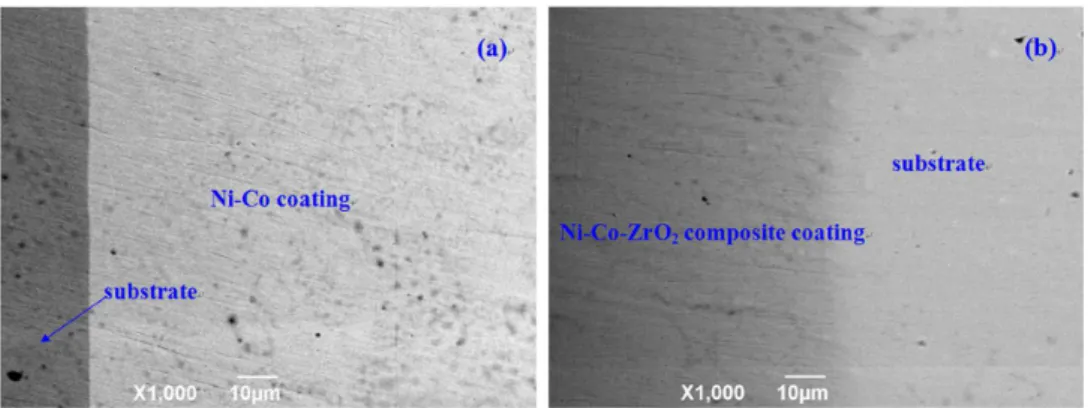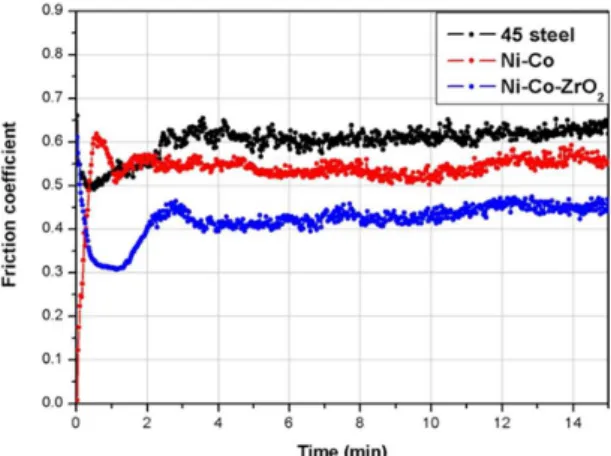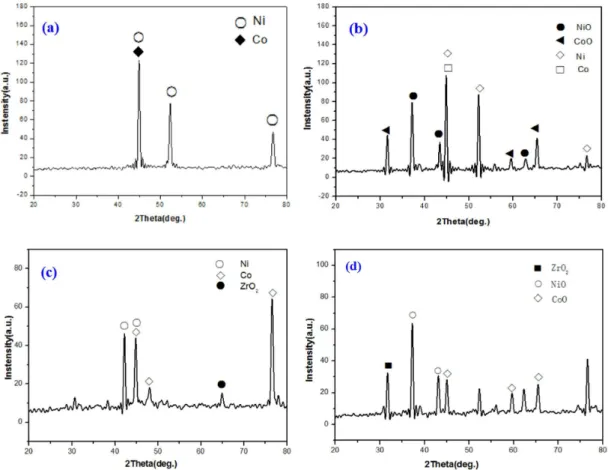*e-mail: sunwanchang@tsinghua.org.cn
1. Introduction
In modern industries, carbon steels are widely used as a structural material for a variety of engineering applications. However, carbon steels are easy to suffer an attack in aggressive solutions and atmospheres because of its high corrosion and oxidation rate 1. Moreover, many carbon steel mechanical products and parts should be able to work steadily for long term, especially under high temperature, high-pressure and high-speed conditions. For example, in hot forging processing, works failed due to high temperature wear is a serious problem, and 70-80% of dies in hot environments are damaged by wear. The prolonged life and reduced cost of die is achieved by the use of the anti-wear materials in high temperature environments 2. Therefore, in order to improve the wear, corrosion and high temperature oxidation resistance of carbon steels, surface strengthening techniques are still needed to increase the service life and reliability and to improve the performance and quality of mechanical equipment. Fine particles reinforced metal matrix composite coatings are made up of matrix metal and evenly dispersed second-phase particles such as ZrO23, B4C 4, Si
3N4
5, WC 6, Al 2O3
3,5,7, CeO 2
8, SiC 5,9,10, possessing
excellent comprehensive performance. ZrO2 is commonly used as the second ceramic phase due to its high hardness, low thermal conductivity and high temperature oxidation resistance. At the same time, Ni-Co alloys are important as they possess high temperature wear and corrosion resistance because it is hardened by the addition of cobalt (Co) into nickel (Ni) in a form of solid solution which does not
embrittle during the heat treatment 11-12. For Ni-Co alloys possess excellent mechanical and chemical properties, incorporating ZrO2 particles into Ni-Co matrix achieved by electrodeposition presents particular chemical and physical properties, leading to a new class of composite coating 7-9. Currently, most research works focus on improving the hardness, corrosion and wear resistance, and electrocatalytic activity of Ni-Co alloy matrix composite coatings 7-9,13. However, the researches on high temperature tribological behavior and the high temperature oxidation resistance of Ni-Co-ZrO2 composite coating have been less reported yet. In this work, submicron ZrO2 particles reinforced Ni-Co alloy composite coating was prepared by electrodeposition and its high temperature tribological behavior and its high temperature oxidation resistance were investigated. In the meantime, the phase structure and surface morphologies were also analyzed. For comparison, the Ni-Co alloy coating was also prepared.
2. Experimental details
The electrodeposition was carried out using a ZD-A direct current power supply. Two nickel samples with the size of 70×20×5 mm3 were used as the anode, and 45 steel sample with the size of 12×12×5 mm3 was used as the cathode. The average particle size was about 0.58 µm. ZrO2 particles were subjected to hydrochloric acid with a concentration of 37.5% for 6 h to remove metal impurities that may exist. The particles were lushed with distilled water till neutral and dried for later use. Prior to the co-deposition,
Fabrication and High Temperature Friction Behavior and Oxidation Resistance of
Ni-Co-ZrO
2Composite Coating
Wan-chang Suna*, Jia-wei Gua, Pei Zhanga, Miao-miao Tiana, Ying Wanga, Hui Caia, Shui-feng Hua
aCollege of Materials Science and Engineering, Xi’an University of Science and Technology,
Xi’an, Shaanxi, 710054, P.R. China
Received: February 6, 2015; Revised: January 8, 2016; Accepted: March 7, 2016
Ni-Co alloy and ZrO2 micron particles were codeposited on 45 carbon steel by electrodeposition. The composition and microstructure of the composite coating were characterized. The high temperature tribological properties were carried out by a pin-on-disk tribo-tester. Additionally, the oxidation resistance was evaluated via high temperature circulating oxidation test. The results indicated that the deposited composite coating showed dispersed ZrO2 particles and continuous Ni-Co matrix, and there were no obvious pores, cracks and other defects at the interface between the composite coating and the substrate. The embedded ZrO2 particles changed the friction mechanism from adhesive wear to abrasive wear, the wear loss rate and friction coeficient of Ni-Co-ZrO2 composite coating were lower in comparison with that of Ni-Co alloy coating and carbon steel substrate. In addition, the embedded ZrO2 particles exerted a reactive-phase effect on the growth of nickel oxide and cobalt oxide, and effectively reduced the oxidation rate of the substrate at high temperature. Therefore, the Ni-Co-ZrO2 composite coating presents better oxidation resistance, when compared with Ni-Co coating.
China). Si3N4 ball (hardness > HV1300) was used as the counter-body. The tests were conducted on a track radius of 5 mm under a load of 10 N and a sliding speed of 0.293 m/s for 15 min. The friction coeficients and sliding time were recorded automatically during the test. Each of friction pairs was cleaned by ultrasonic washing in acetone before and after each test. An electrical balance was used to weigh the samples before and after each wear test, so as to calculate the weight loss of the coatings.
High temperature oxidation tests were carried out in a mufle furnace in static air. The temperature of the furnace was maintained at a set value by an automatic controller with precision of ±2 K. The oxidation experiments were carried out at 573 K, 873 K and 1173 K for 2 h, respectively, and at 873 K for different exposure time 14-16. After oxidation, the samples were withdrew from the furnace and cooled in air without air low, and then weighed the samples by using an electronic balance with an accuracy of 0.01 mg.
Japan) with a CuKα radiation.
3. Results and discussion
3.1 Morphology observation and EDS analysis
Fig. 1(a) shows the surface SEM micrographs of the Ni-Co coating. It is clearly that Ni-Co coating presents typical crystal morphology with average uniform particle size of about 4 µm. The larger crystal particles size makes the coating surface coarse relatively. Fig. 1(b) shows the surface SEM micrographs of the Ni-Co-ZrO2 composite coating prepared on 45 steel substrate. It can be seen that the obtained composite coating possesses a mat-gray smooth metallic surface with ine and compact white spots which are visible to naked eye. And in Fig. 1(d), we can see that each white ZrO2 particle size is less than 1 um, it means the distribution of ZrO2 particles is favorable. Fig. 2(a) presents the cross-section micrograph of Ni-Co composite coating, showing continuous and good combinations between the coating and the substrate, and there are no obvious defects between the composite coating and the substrate. And Fig. 2(b) shows the cross-section micrograph of Ni-Co-ZrO2 composite coating, which presents dispersed ZrO2 particles and continuous Ni-Co matrix, and there are no pores and cracks and other defects at the interface.Fig. 3 (a) shows the EDS analysis which shows that the composition of coating is Ni-Co alloy and there are no impurities in the coating. Fig. 3 (b) illustrates the EDS analysis data, which strongly suggest that the composition of coating are nickel cobalt (Ni-Co) alloy and ZrO2 particles, and it also reveals much higher content of cobalt (67.69wt%) than that of nickel (29.68wt%) in the composite coating. Co-rich
Table 1. Composition of plating solution and experiment conditions
NiSO4·6H2O 210 g/L
CoSO4·7H2O 95 g/L
H3BO4 20 g/L
Sulfourea 10 mg/L
ZrO2 (0.58 μm) 60 g/L
Parameters for equipment setup
Current density 8 A/dm2
Magnetic stirring rate 250 rpm
Temperature 328 K
pH 2.5~3.5
Plating duration 80 min
Fig. 2 SEM micrographs of the cross-section: (a) Ni-Co coating (b) Ni-Co-ZrO2 composite coating.
composite coating. The wear rate decreases from 25.1×10 mg/m for 45 steel down to 22.3×10-3 mg/m for Ni-Co coating and further down to 14.8×10-3 mg/m for Ni-Co-ZrO
2 composite coating. Fig. 4 demonstrates that Ni-Co-ZrO2 composite coating possesses the best wear resistance. The decrease of the wear rate of Ni-Co-ZrO2 composite coating, as compared with Ni-Co coating, is rationally understood because of the plastic deformation of the matrix material under the load by way of the ZrO2 particles dispersion strengthening.
Fig. 5 shows the relationships between friction coeficient and the sliding time for 45 steel, Ni-Co alloy coating and Ni-Co-ZrO2 composite coating at 873 K. It shows that the friction coeficient of Ni-Co-ZrO2 composite coatings is
photographs of a typical worn surface of 45 carbon steel at 873 K, Fig. 7(a) shows that there is a wide and dark furrow along the sliding direction. From Fig. 7(b), it can be seen that the entire surface of 45 steel after oxidation is dark, the oxidation is heavy, and it further identiies that the darker areas in Fig. 7(a) are indeed a deep groove. The groove means that the wear loss will be high. The result as just mentioned could be attributed to the brittle oxide layer, which cannot effectively prevent the substrate from sliding cut from the micro-contact surface of counter-part 16.
Fig. 7(c-d) presents the wear trace of Ni-Co coating. Arrows in Fig. 7(d) shows that there are many cracks vertical with the sliding tracks, and the integrity of coating was poor. The darker areas directed by the arrows were oxides, which were formed during the high temperature tribo-test. The indents generated in the alloy coating surface along the sliding direction were formed by the welding phenomenon, which was caused by imprisoning the fragments between the specimen surface and the pin. Fig. 7(e-f) presents the worn morphologies of Ni-Co-ZrO2 composite coatings. During the wear test, the ZrO2 particles carry the load and prevent Ni-Co matrix from wearing by way of dispersive strengthening as discussed in paragraph 1 of section 3.2, and when a large number of ultra-ine ZrO2 particles were dug out by counter-body from the coating surface. The friction mechanism was transformed from pure sliding to partly rolling, which reducing the friction force and smoothing the counter surface in a similar way by polishing it with ultra-ine particles. Compared with Ni-Co coating, Ni-Co-ZrO2 composite coatings had the small and slight cracks, it is because ZrO2
Fig. 4 Wear weight loss of 45 steel, Ni-Co alloy coating and Ni-Co-ZrO2 composite coating at 873 K for 15 min.
Fig. 5 Friction coeficient of 45 steel substrate, Ni-Co alloy coating
and Ni-Co-ZrO2 composite coatings at 873 K.
Fig. 6 XRD pattern of Ni-Co-ZrO2 composite coatings after high
particles could reinforce composite coating and hinder the growth of the cracks, and hence the friction coeficient became lower, it was also conirmed by Fig. 5. Ni-Co-ZrO2 composite coating possesses better oxidation resistance than that of Ni-Co coating and 45 steel as discussed earlier, so Ni-Co-ZrO2 composite coating was not oxidized so heavily as Ni-Co coating and 45 steel. Compared with Fig. 7(a-b) and (c-d), it can be seen from all SEM morphologies that the surface of Ni-Co-ZrO2 composite coating is the smoothest, the integrity is the best and the oxidation is the lightest. So the Ni-Co-ZrO2 composite coating possesses higher
wear resistance and lower wear rate than that of Ni-Co alloy coating and 45 steel.
3.3 Oxidation resistance
The oxidation experiments were carried out at 573 K, 873 K and 1173 K for 2 h, respectively. Fig. 8 shows the weight gain of 45 carbon steel, Ni-Co alloy coating and Ni-Co-ZrO2 composite coating at different temperatures. From Fig. 8, it can be seen that with the increase of the temperature, the weight gain of 45 steel, Ni-Co alloy coating and Ni-Co-ZrO2 composite coating are all increased. When
Ni-Co-ZrO2 composite coating are lower than that of Ni-Co alloy coating, and it means that Ni-Co-ZrO2 composite coating possesses better oxidation resistance than that of Ni-Co coating.
Fig. 10 shows the cross-section micrographs of the Ni-Co coating and Ni-Co-ZrO2 composite coating after high temperature oxidation test at 873 K for 6 h. It was found that the surface of Ni-Co coating appears black oxide, accompanied by a little crack. In contrast, Ni-Co-ZrO2 composite coating is still intact, and there are no crack and fall off. And in Fig. 10(b), we can see that the oxide layers obviously. It can be conirmed that the oxide layer of Ni-Co-ZrO2 composite coating is smooth and uniform in comparison with that of Ni-Co coating after high temperature oxidation test.
Fig. 11 gives EDS analysis of the cross-section micrographs of Ni-Co coating and Ni-Co-ZrO2 composite coating after high temperature oxidation test at 873 K for 6 h. It shows that the oxide layers contain the elements of Ni, Co and O. Fig. 12 shows the line scanning analysis diagram, suggesting that the oxygen content in the coating increases and the content of Co is still high. It can be demonstrated that the oxide layer has formed on the surface of Ni-Co coating and Ni-Co-ZrO2 composite coating. However, the content of embedded ZrO2 particles in the Ni-Co-ZrO2 composite coating decreases after high temperature oxidation test, the reason why the ZrO2 particle decreases needs to be further explored.
Fig. 13 shows the SEM micrographs of surface morphology of Ni-Co coating and Ni-Co-ZrO2 composite coating after high temperature oxidation test. The aggregation particles of Ni-Co composite coating on the surface are uneven, where appears some irregular lumps; however, the particles of Ni-Co-ZrO2 composite coating on the surface are uniform
Fig. 8 Weight gain of 45 steel, Ni-Co alloy coating and Ni-Co-ZrO2 composite coating after oxidation test for 2 h at different temperatures.
Fig. 9 Weight gain of 45 steel, Ni-Co alloy coating and Ni-Co-ZrO2 composite coating after high temperature oxidation test at 873 K.
and tiny, which conirms the analysis of the oxidation weight gain curves of two coatings.
Fig. 14 presents the X-ray diffraction patterns of Ni-Co coating and Ni-Co-ZrO2 composite coating. Fig. 14(a),(c) show XRD patterns of Ni-Co coating and Ni-Co-ZrO2
composite coating before high temperature oxidation test, and Fig. 14(b),(d) show XRD patterns of Ni-Co coating and Ni-Co-ZrO2 composite coating after high temperature oxidation test for 6 h at 873 K. It can be seen that NiO and CoO formed after high temperature oxidation test.
Fig. 12 Line scanning analysis diagram after high temperature oxidation test for 6 h at 873 K (a) Ni-Co coating (b) Ni-Co-ZrO2 composite coating
In summary, it is well known that the oxygen diffusion through the coating is the dominant diffusion mechanism during the oxidation process 3. The reason why Ni-Co-ZrO
2 composite coatings can improve the high temperature oxidation resistance is that the dispersive ZrO2 particles in the Ni-Co matrix reduce the effective area of Ni-Co alloy contacting with ambient oxygen. Furthermore, the ZrO2 particles exert a reactive-phase effect on the growth of NiO and CoO in the composite coating and effectively reduce the oxidation rate of the composite coating at high temperature. In addition, new phases like NiO and CoO further prevent inward oxygen diffusion. It is also one of the important factors that enable the composite coating to achieve high temperature oxidation resistance.
4. Conclusions
1) Ni-Co alloy and ZrO2 micron particles were codeposited on 45 steel by electrodeposition and the deposited composite coating shows dispersed ZrO2 particles and continuous Ni-Co matrix, and there are no pores and cracks and other defects at the interface between the composite coating and the substrate.
Fig. 14 XRD pattern before and after high temperature oxidation test for 6 h at 873 K (a) (b)of Ni-Co coating (c) (d) Ni-Co-ZrO2
composite coating
2) The embedded ZrO2 particles change the friction mechanism from adhesive wear to abrasive wear. The wear loss rate and coeficient of Ni-Co-ZrO2 composite coating are lower than that of Ni-Co alloy and much lower than that of 45 steel, and the Ni-Co-ZrO2 composite coating possesses the best high temperature wear resistance.
3) The embedded ZrO2 particles exert a reactive-phase effect on the growth of nickel oxide (NiO) and cobalt oxide (CoO) and effectively reduce the oxidation rate of the substrate at high temperature. The oxidation weight gain of Ni-Co-ZrO2 composite coating is lower than that of Ni-Co coating, demonstrating that the Ni-Co-ZrO2 composite coating presents better high temperature oxidation resistance.
Acknowledgments
stainless steel. Materials Chemistry and Physics. 2010;123(2):731-736. doi:10.1016/j.matchemphys.2010.05.047
4. Araghi A, Paydar MH. Electroless deposition of Ni-P-B4C composite coating on AZ91D magnesium alloy and investigation on its wear and corrosion resistance. Materials and Design. 2010;31(6):3095-3099. doi:10.1016/j.matdes.2009.12.042
5. Srivastava M, William Grips VK, Rajam KS. Inluence of
SiC, Si3N4 and Al2O3 particles on the structure and properties
of electrodeposited Ni. Materials Letters. 2008; 62(20):3487-3489. doi:10.1016/j.matlet.2008.03.008
6. Zoikis-Karathanasis A, Pavlatou E A, Spyrellis N. The effect of heat treatment on the structure and hardness of pulse electrodeposited NiP-WC composite coating. Electrochimica Acta. 2009;54(9):2563–2570. doi:10.1016/j.electacta.2008.07.027 7. Wu G, Li N, Zhou DR, Mitsuo K. Electrodeposited Co-Ni-Al2O3 composite coatings. Surface and Coatings Technology.
2004;176(2):157-164. doi:10.1016/S0257-8972(03)00739-4
8. Srivastava M, William Grips VK, Rajam KS. Electrodeposition of Ni-Co composites containing nano-CeO2 and their structure, properties. Applied Surface Science. 2010; 257(3):717-722. doi:10.1016/j.apsusc.2010.07.046
Laboratories Report No. SCL-DR-720090; 1972.
13. Wu G, Li N, Dai CS, Zhou DR. Electrochemical preparation and characteristics of Ni-Co-LaNi5 composite coatings
as electrode materials for hydrogen evolution. Materials Chemistry and Physics. 2004;83(2-3):307-314. doi:10.1016/j. matchemphys.2003.10.005
14. Yuan QL, Ling WD, Li P. High temperature oxidation resistance
of nickel-base nano-ZrO2composite coating prepared with electro-brush plating. Journal of Functional Materials. 2012;21(43):2930-2933.
15. Zhang H, Hu YM, Guo ZC. Oxidation resistance of pulse
electrodeposited Ni-W-P-SiC composite coating. Corrosion & Protection. 2006;27(6):280-283.
16. Wang XH, Xu BS, Hu ZF, Dong SY, Jin P. A research on
microstructure and properties of n-Al2O3/Ni-Co composite coatings. Electroplating & Pollution Control. 2010;30(6):12-15.






